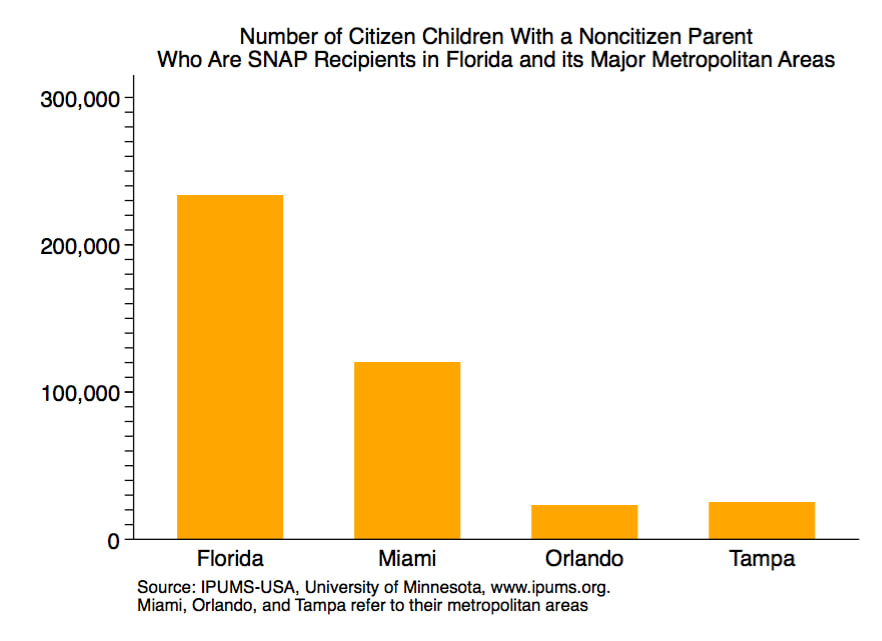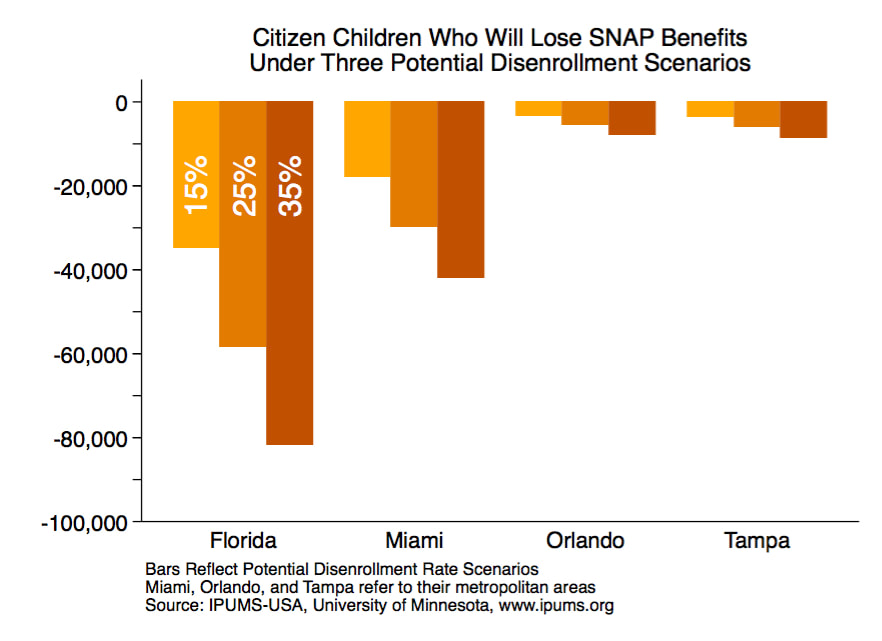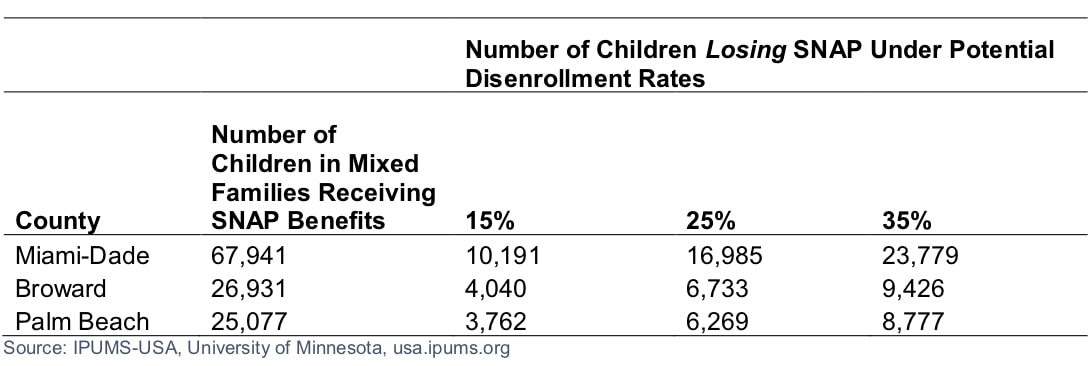|
By Matt Childers, Ph.D. Updated November 14, 2018 On October 10, 2018, the Trump Administration published proposed changes to the “public charge” immigration rules that govern how the use of public benefits affect an immigrant’s legal status. These changes are likely to harm millions of immigrant families across the country, but states with large immigrant populations will be disproportionately affected. In this brief, we analyze the impacts that the proposed changes will have on SNAP enrollment (food stamps) among U.S.-born children in “mixed-status” families in Florida and its major metropolitan areas. (By “mixed-status,” we refer to families whose children are citizens, but one or both of the parents are not.) We find that over 80,000 kids will lose SNAP benefits across the state and over half of them reside in the Miami metropolitan area. Background In the proposed rule, the government would redefine who is a “public charge” and expand the criteria used in making that evaluation. When an immigrant seeks either legal entry into the U.S. or lawful permanent status, the government determines whether they will become a “public charge,” and if so, they can deny the application. Current policy defines a public charge as someone who is primarily dependent on the government for subsistence. In making such determinations, the government is only allowed to consider whether the applicant receives (or is likely to receive) cash assistance (like SSI or TANF) or government subsidized institutionalized long-term care. The changes proposed by the Department of Homeland Security would alter the public charge regulations in significant ways that will dramatically affect immigrants to the U.S. It would redefine a public charge as an immigrant who uses or receives one or more public benefits and broadens the scope of programs that fall under the scope of public benefits that are considered in its determination.[i]The expanded list of benefits include: Medicaid, Medicare Part D Low Income Subsidy Program, Supplemental Nutrition Assistance Program (SNAP), and public housing assistance (including Section 8 Housing Voucher Program, Section 8 Rental Assistance) in addition to the benefits already described above. The Chilling Effect of the Proposed Changes and Benefits of SNAP for Children’s Health and Economic Well-being If the proposed rule goes forward, we expect it to reduce immigrant families’ participation in government safety net programs. While the public charge rule does not apply to immigrants with green cards, many of them will fear that using public benefits would negatively affect their legal status. We saw similar confusion among immigrants after welfare reform in the 1990s when their participation in programs like Medicaid and SNAP declined significantly. Reducing the number of families receiving food stamps would cause irreparable harm for their children. Research clearly shows that low-income children in the SNAP program are healthier over the long-term than other low-income children who were not in the program. If families choose to disenroll from SNAP out of fear of what the consequences might be, they will have less money to spend on utilities and other bills as they struggle to make ends meet. They may be pushed further into poverty and their children may not have enough food to eat on a daily basis. Consequently, this can cause the children to perform poorly in school and more generally it may harm their cognitive, social, and emotional development. Decreased Enrollment in SNAP Among Florida’s Eligible Children Census data show that there are over 233,000 children in Florida in mixed-status families who are enrolled in SNAP. As shown in the first graph below, half of them live in the Miami metropolitan area, which includes: Miami-Dade, Broward, and Palm Beach Counties. To estimate the chilling effect, we present three potential scenarios of disenrollment rates among mixed status families in Florida and its three largest metropolitan areas. The Kaiser Family Foundation used these same scenarios to measure how the changes in the public charge rule would impact Medicaid and CHIP beneficiaries on a national scale. They chose their rates based on scholarly research of how the 1990’s welfare reform laws impacted immigrant families. If we observe a drop-off rate of 15% across the state overall, 35,000 children will lose SNAP benefits. 58,400 will lose SNAP if 25% of families disenroll and 82,000 will lose SNAP with a disenrollment rate of 35%. In the Miami metro, we could see between approximately 18,000 and 42,000 children lose SNAP benefits under the same scenarios. This is more than four times what the impact will be in the Orlando and Tampa areas, respectively. The Impact in South Florida Within the Miami metropolitan area, children in Miami-Dade County will suffer the most if the proposed changes are approved. The table below shows the same type of data shown thus far, but for the three counties in the Miami metropolitan area. 56% of the children in the table receiving SNAP benefits in the Miami metropolitan area reside in Miami-Dade County. Thus, over half of the losses due to the likely chilling effect that will occur in South Florida will be felt in Miami-Dade County. Note: The number of citizen children who would be adversely impacted under the draft rule is significantly higher than the data above for multiple reasons: 1) this analysis does not include an estimate of the children who are currently eligible but not enrolled in the program and 2) the chilling effects from the changes in the public charge rule are likely to be much greater than what we estimate here because this is policy change that is directly targeting immigrants. The chilling effects shown in previous research that we cite here measured unintended consequences of the 1990s welfare reform, which was not meant to directly target immigrants.
For more information, please visit the Protecting Immigrant Families website. If you have any questions, please contact Matt Childers, Ph.D., at childers at floridahealthjustice.org. Comments are closed.
|
Sign-up For Email Updates |
The Florida Health Justice Project, a nonprofit organization, recognizes that access to quality and affordable health care is a human right and engages in comprehensive advocacy to expand healthcare access and promote health equity for vulnerable Floridians.
A COPY OF THE OFFICIAL REGISTRATION AND FINANCIAL INFORMATION MAY BE OBTAINED FROM THE DIVISION OF CONSUMER SERVICES BY CALLING TOLL FREE WITHIN THE STATE AT 1-800-435-7352 . IT CAN ALSO BE FOUND AT WWW.800HELPFLA.COM. REGISTRATION DOES NOT IMPLY ENDORSEMENT, APPROVAL OR RECOMMENDATIONS BY THE STATE.
|











